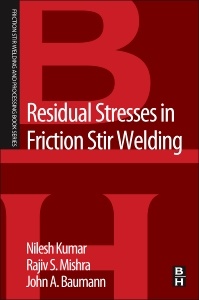Residual Stresses in Friction Stir Welding Friction Stir Welding and Processing Series
Auteurs : Kulkarni Nilesh, Mishra Rajiv S., Baumann John A.

This book describes the fundamentals of residual stresses in friction stir welding and reviews the data reported for various materials. Residual stresses produced during manufacturing processes lead to distortion of structures. It is critical to understand and mitigate residual stresses. From the onset of friction stir welding, claims have been made about the lower magnitude of residual stresses. The lower residual stresses are partly due to lower peak temperature and shorter time at temperature during friction stir welding. A review of residual stresses that result from the friction stir process and strategies to mitigate it have been presented. Friction stir welding can be combined with additional in-situ and ex-situ manufacturing steps to lower the final residual stresses. Modeling of residual stresses highlights the relationship between clamping constraint and development of distortion. For many applications, management of residual stresses can be critical for qualification of component/structure.
- Reviews magnitude of residual stresses in various metals and alloys
- Discusses mitigation strategies for residual stresses during friction stir welding
- Covers fundamental origin of residual stresses and distortion
- Introduction
- Residual stresses in friction stir welding process
- Effect of residual stresses on properties
- Parameters affecting residual stresses
- Characterization of residual stresses
- Mitigation of residual stresses during FSW
- Simulation of friction stir welding for residual stresses and distortions
- Summary, conclusions, and future directions
- References
Researchers, welding engineers, materials processing engineers, design engineers and students
Rajiv S. Mishra is a professor in the Department of Materials Science and Engineering, and Site Director, NSF IUCRC for Friction Stir Processing, at the University of North Texas. Dr. Mishra’s publication record includes 255 papers with an h-index of 39. Out of these, 10 of his papers have more than 100 citations. He has many ‘firsts’ in the field of friction stir welding and processing. He co-authored the first review paper (2005), co-edited the first book on the subject (2007), edited/co-edited seven TMS symposium proceedings, and served as guest editor for Viewpoint Set in Scripta Materialia (2008). He also has three patents in this field. He published the first paper on friction stir processing (2000) as a microstructural modification tool.
- Reviews magnitude of residual stresses in various metals and alloys
- Discusses mitigation strategies for residual stresses during friction stir welding
- Covers fundamental origin of residual stresses and distortion
Date de parution : 11-2013
Ouvrage de 60 p.
15.2x22.8 cm
Disponible chez l'éditeur (délai d'approvisionnement : 14 jours).
Prix indicatif 43,92 €
Ajouter au panier


